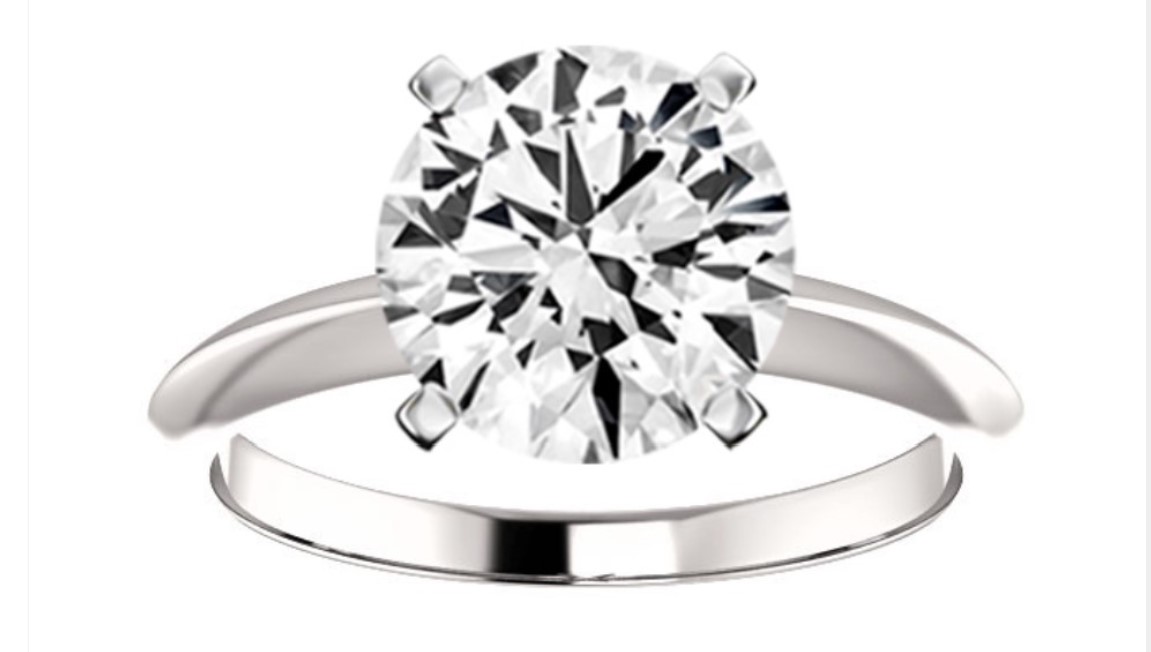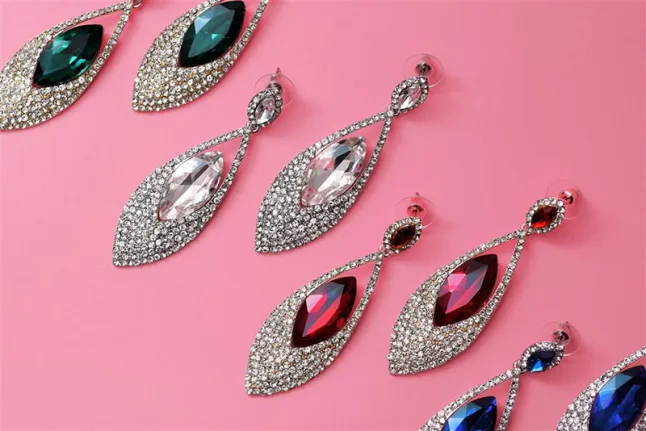Meaning of Gem Colors in Rings | Rare Carat
As humans, it is instinctual for us to look for meaning and order in the world around us. Based on their durability, beauty, geographic origin, and - most certainly - color, gemstones have been imbued with attributes that can serve to both empower and embolden the wearer. They may remind us of valuable moral lessons, keep happy memories alive, signify commitment, improve our health, or even actively enhance our better natures. Interestingly, there is science behind the psychological responses that individuals have when observing particular colors. The history of the meanings behind gemstones is one that reaches back millennia and is interwoven into every culture. Let’s work our way through the rainbow to learn what different reactions gemstone colors can evoke both on conscious, and unconscious, levels.

Red
Here’s one that you probably already have some feelings about… Red. It’s the color of passion, strength, romance, and danger. There are psychological reasons why stoplights use red as the indication to stop; whether for good or not, red screams to your brain “Pay attention!” Wearing red stones can make you feel confident and powerful. Red hues are also easy to wear as they flatter any skin tone. Rubies, sometimes known as the “king of colored stones” and the first of the “Big Three,” can command some of the highest price per carat costs on the market. Fortunately, there are lots of different red gemstones – at lots of different price points – to choose from. There are plenty of rubellite tourmalines and garnets available which showcase beautiful, saturated red hues. They may have overtones of other colors, like orange and pink, which provide an attractive complexity and depth to the stone. Spinel is another great option that can be found in large sizes with high clarity. Sometimes priced at a fraction of the cost per carat of rubies, the highest quality spinels have been historically mistaken for rubies. The Black Prince’s Ruby of the Crown Jewels of the United Kingdom was found to be a spinel!
Orange and Yellow
Orange and yellow colors conjure happy feelings reminiscent of the sensation provided by the warmth of the sun. Also associated with intelligence, prosperity, and optimism, these colors are sure to make you feel positive and full of energy when worn! While diamonds can occur in any color, yellow is the most common. Sapphires in this color range are another great choice because of their durability and beauty. Other transparent options include citrine, zircon, and topaz. The chalcedony colors Carnelian and Sard are good semitransparent to opaque options.
Green
Green is a powerful influencer on the human mind. Signifying everything from food, money, fertility, the natural world, and abundance in general, green stones can be used to ellicit many different states of being. Interestingly, our eyes evolved to see more shades of green than any other color. Thus, the wearer may have very different reasons for choosing to keep this color close. Just as green evokes many different outlooks, there are various green gemstones to choose from. The most obvious is the second member of the “Big Three” – the emerald. Due to their saturated tones and liquid clarity, emeralds are among the most popular and valued gemstones across the globe. Other options include the tsavorite, demantoid and peridot stones. Green jade represents a highly valued translucent/opaque option especially favored by individuals from Eastern societies. Culturally, jade, known as the “stone of heaven”, is thought to represent luck, virility, and good health. The finest examples of green jade are termed “imperial” and command tremendous prices. To an educated wearer, putting on a jade ring can be an almost spiritual experience.
Blue
Similar to green tones, blue hues are intimately connected with the natural world. The color of both the sky and water, blues are associated with deep spirituality. Accordingly, just as water gives life, blues are thought to assist in healing. Additionally, as both the sky and sea are eternal, blue can represent steadfastness, loyalty, and calm, and help you to clear your mind. Wearing this color may bolster your self-confidence and allow you to express yourself with greater poise and clarity. There is an abundance of blue stones for you to choose from, including the final member of the “Big Three” – blue sapphires. Tanzanite stones are another good option if you are interested in transparent gemstones. If you are looking for something more opaque, turquoise and lapis lazuli have been used by humans as jewelry for many millennia.

Purple
Due to its rarity and richness, the color purple has developed many different associations. Firstly, it is connected with royalty, sophistication, and luxury. At various points in history in particular cultures, only monarchs were permitted to wear it. Secondly, it is thought to be the color of wisdom and intuition. A few transparent purple gemstone choices include sapphire and spinel. There are more opaque options available to you including lavender jade, sugilite, and charoite.
Pink
Like red, pink shades also are associated with love but with a much softer, more feminine tone. In the context of relationships, pinks evoke a sense of calm and security. They encourage an overall atmosphere filled with positivity and harmony. If you are looking for a truly spectacular investment, you can consider rare pink diamonds. There are also pink species of tourmaline and garnet which fall into a mid-market range. Morganite, a pink version of beryl, and rose quartz can also be a lovely option.
Black
As with purple, black has developed a few different connotations. Stones such as jet and onyx were employed heavily during the Victorian Era as mourning jewelry, i.e., items used as remembrances of loved ones who have passed. This may seem grim, but it carried warm and heartfelt connotations. More recently, perhaps as a result of its connection with mortality, black can be linked to gothic culture. Furthermore, black is associated with mystery and elegance. In addition to the stones already listed, you may find beautifully reflective black spinel and tourmaline options. There are also black diamonds on the market.
Brown
This one should not come as a surprise… Brown is deeply connected with the Earth. The color of fertile soil, brown is an uncomplicated hue that both nurtures and protects. Smoky quartz and Tiger’s eye are commonly worn as talismans to fill the wearer with confidence and overcome fears. Topaz is another affordable option. Amber is made of tree sap that was made to protect the plant that has hardened over a period of a million years or more. It is literally a protective organic substance!
White
There are several different associations that likely jump to mind when you consider the color white. The most obvious is purity, both in an emotional/spiritual sense, as well as a physical. White represents a blank slate, an optimistic fresh start, and it is clear why this color is favored by many brides. Pearls have traditionally been worn as demure, feminine jewelry. However, now available in different sizes, shapes, and hues, pearl jewelry is transitioning into a responsible, no-nonsense and practical option favored by working women. White jade and moonstones are additional white options that may catch your eye.

If you want to add personal color choices, Rare Carat offers custom engagement rings that incorporate different gemstones.
Color-Change
Color-change stones have preoccupied mankind’s attention because they naturally invite individuals to interpret what the transitioning color reveals about themselves. Sapphires, garnets and alexandrites are among the naturally occurring color-change gemstones that you will see.
Messages Hidden in Color
The significance of the color of the gemstone on your ring can go beyond basic color psychology. It was common in Victorian culture to use colored gemstones to spell out a message, a practice called acrostic jewelry. Words of love such as “dear” or “adored” could be spelled out using stones whose first letters lined up to spell that word (“diamond, emerald, amethyst, ruby” or “amethyst, diamond, opal, ruby, emerald, diamond”).
When choosing the right color gemstone to put on, take a minute to consider what the coming day holds in store for you. Are you going into an intimidating situation and need color to fill you with confidence? Perhaps it’s the opposite and you need a day to destress and want an option to help calm and clear your mind. What is most important is how a particular color makes you feel.

